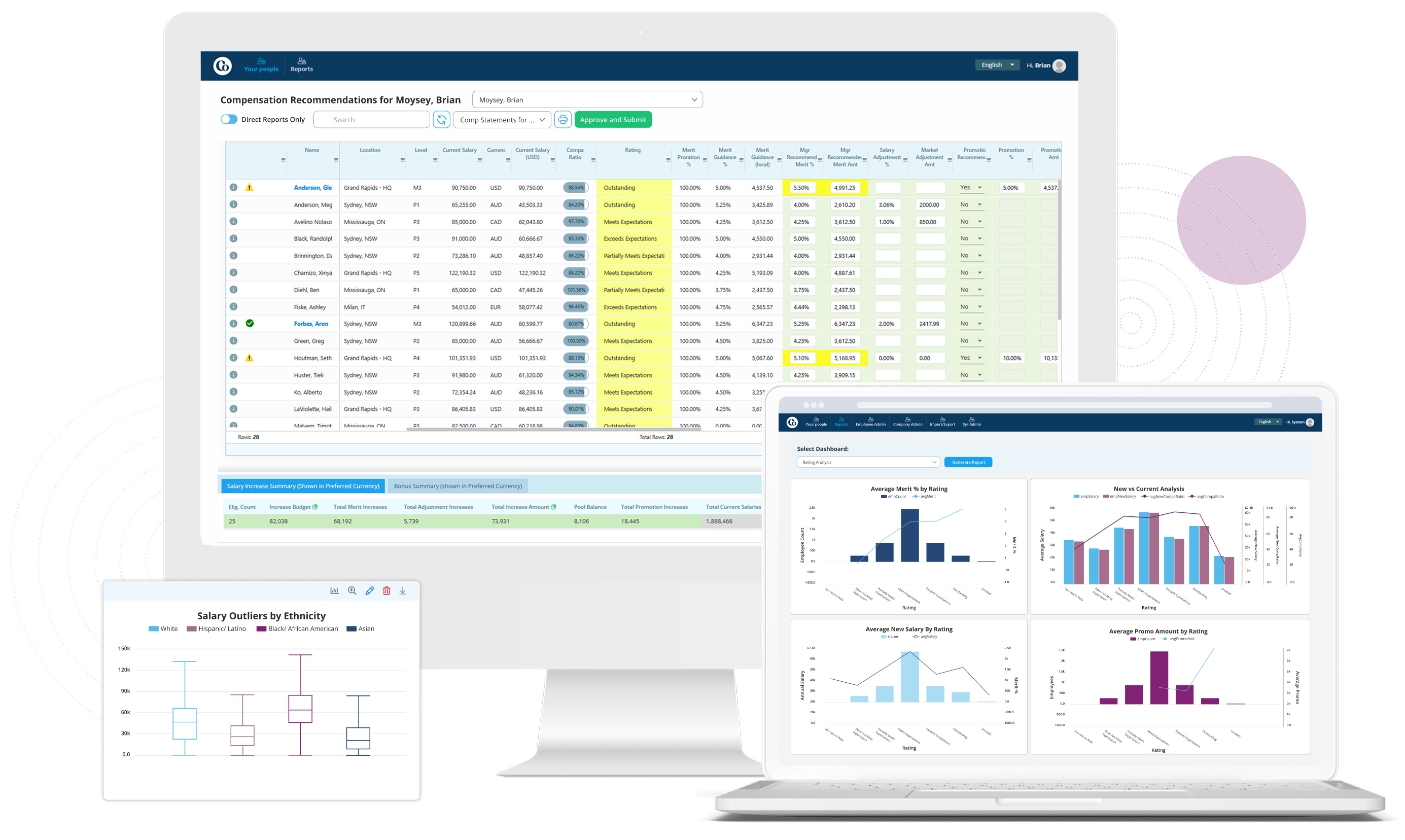Like many aspects of HR, your team is dealing with unfamiliar challenges in an already complex function — employee compensation management. From rising employee expectations to navigating new pay transparency laws, creating a solid compensation strategy is getting increasingly complicated. If you don’t clear these hurdles, they can have a negative impact on retention, engagement, and your ability to attract top talent. The research says it all:
- Employees who feel they’re paid fairly are 85% more engaged and 62% more committed to their company.
- Companies that increased, or are working on increasing, pay transparency are 18% more likely to say they are “highly effective” at recruiting than those that have not.
Luckily, you can overcome these challenges in compensation management with the right approach. Keep reading for more on the top eight compensation issues HR is facing right now, plus some actionable strategies for addressing them effectively.
1. The Challenge: Complex Compensation Structures
Compensation and benefits packages aren’t always straightforward — for your employees and for your HR team, too. They’re responsible for promoting pay equity, balancing perks and benefits, and understanding tax implications and legal requirements.
If employees don’t understand your company’s compensation practices, that can lead to dissatisfaction and mistrust. If your HR team doesn’t understand it, you’re playing with fire, increasing the likelihood of errors, inequities, and compliance issues.
The Solution: Simplicity and Clarity
When it comes to complex compensation structures, less is often more. Start by streamlining pay structures wherever you can. Cut out unnecessary layers that confuse employees and create headaches for your HR team.
Clarity is just as important as simplicity. Create easy-to-understand resources, like guides, FAQs, or charts, that break down your compensation practices. When employees know what to expect, trust and satisfaction naturally follow.
Technology can be your best friend here. Use compensation management software to automate tricky calculations, track variables like bonuses and equity, and avoid mistakes. Software helps reduce risk and effortlessly keeps accurate, organized records.
Your managers are key players, too. Train them to confidently explain and justify compensation decisions, so they can answer questions and concerns and build transparency with their teams. Last but not least, make regular reviews a priority. Audit your compensation structures regularly to check that they’re fair, competitive, and still working for your business.
Comp Management Tip #1: Use a compensation tool that can handle all types of pay — salary, bonuses, equity, and more — so you can see the full picture at a glance.
2. The Challenge: Budget Constraints
Balancing fair, competitive compensation with your organization’s budget is no easy task. The pressure to manage costs while attracting and retaining top talent can feel like walking a tightrope. Pay too little, and you risk losing great employees to competitors. Pay too much, and you could strain resources, limiting your ability to invest in other critical areas of the business.
Compensation plays a huge role in hiring and retention, but it’s not just about offering the highest salary. Striking the right balance is key to remaining competitive without overspending, ensuring your company can grow sustainably while keeping employees engaged and motivated.
The Solution: Equity and Balance
Start with the data. Conduct regular compensation analyses, using data from market research and benchmarking, to understand what competitive pay looks like for your industry, location, and roles. Use data-driven tools to identify fair pay ranges that align with market standards and your budget.
Remember, compensation isn’t just about salary. Focus on total rewards — things like benefits, perks, and flexibility — that can make your offer more attractive without breaking the bank. Flexible hours and work location are employees’ most desired perks after a good salary. Your people value work-life balance, career development, and recognition just as much as a paycheck, so think creatively about how to deliver value beyond dollars.
Comp Management Tip #2: Look for a compensation planning solution that lets you set budgets by demographics like country, department, or cost center. Pair that with performance metrics, compa-ratio, or other guidance to get a clear view of how your budget aligns with pay increase recommendations.
3. The Challenge: Keeping Up With Market Rates
Staying on top of market rates for different roles and regions is critical for offering competitive pay. But researching benchmarking data and salary surveys eats up lots of time, and the market is always changing.
The Solution: Consistency and Insight
Make benchmarking a regular habit. Use reliable data sources to understand pay trends for specific roles and locations, and adjust your compensation strategy accordingly. The right tools can make this process easier by centralizing market data and automating calculations like compa-ratio or pay ranges, so you’re always working with up-to-date information.
Comp Management Tip #3: Choose a benchmarking solution that covers the specific jobs and locations you need. Sometimes, multiple sources are necessary to get the full picture. Make sure your system can store and use this data for seamless compensation planning.
4. The Challenge: Pay-For-Performance Calculations
Aligning compensation with performance isn’t as simple as it sounds. Setting up and managing performance-based pay structures requires objective performance measurement, clear communication, and a system that ensures fairness. Without the right tools and processes, it’s easy for subjectivity to creep in, leading to inconsistencies and frustration.
The Solution: Objectivity and Structure
Make sure managers are trained to evaluate performance fairly and stick to your performance management model. Combine this with accurate performance data and reliable salary benchmarks to create a clear guidance matrix. This matrix helps you connect pay to performance in a way that’s fair, consistent, and motivating for your top performers.
Comp Management Tip #4: Equip managers with the training and tools they need to give fair evaluations. Use a guidance matrix that combines performance data with salary benchmarks to ensure your highest performers are rewarded appropriately and retained long-term.
5. The Challenge: Pay Equity
Pay gaps based on gender, race, or other factors can quietly undermine your workplace. Pay inequities damage trust, hurt morale, and tarnish your employer brand, making it harder to attract and retain top talent.
The Solution: Fairness and Accountability
Start by performing regular audits of compensation packages to uncover and address any disparities. Build transparent pay structures and policies that ensure fairness across the board. Finally, train managers to recognize and eliminate bias in pay decisions, so equitable practices become the norm.
Comp Management Tip #5: Use your compensation solution to analyze pay equity by leveraging benchmark data and identifying gaps across demographics. After correcting discrepancies, provide employees with total compensation statements to demonstrate your commitment to fairness and transparency.
6. The Challenge: Pay Transparency
Pay transparency laws have become widespread over the past several years, adding a new layer of difficulty to managing compensation. Pay transparency is also extremely popular with employees and job seekers, to the point where many businesses have adopted it without being required. As one expert put it, “[pay transparency is] just going to be the standard business practice.”
Without pay transparency, mistrust and disengagement can grow, creating bigger problems down the line.
The Solution: Clarity and Gradual Change
Develop clear communication about your pay policies and structures. Share how compensation decisions are made — whether they’re based on performance, market data, or other factors. If full transparency feels like too much at once, start small and introduce it gradually to build trust over time.
Comp Management Tip #6: Start by sharing general salary ranges and how they’re determined using benchmark data. Use your tech solution to create personalized total compensation statements. These help employees understand their pay in the context of market benchmarks, building trust and confidence in your compensation process.
7. The Challenge: Global Rules and Requirements
If your company operates in multiple countries, managing pay can get tricky. Different currencies, legal requirements, and cultural expectations around pay and benefits all add layers of complexity.
The Solution: Localized Tools and Flexibility
A good compensation system makes it easier to handle these challenges. Look for one that lets you manage pay increases in local currencies while showing reports in your preferred currency. It should also allow you to set up custom rules to meet the specific needs of each country, so you can stay compliant and respectful of local practices.
Comp Management Tip #7: Use a compensation solution that supports local currencies and makes it simple to convert data for reports. Make sure it also lets you create rules for each country to handle legal and cultural differences with ease.
8. The Challenge: Retention and Motivation
Attracting and retaining top talent isn’t just about offering competitive pay — it’s about creating a workplace where employees feel supported, trusted, and connected to your company’s mission. Pay equity and transparency are critical pieces of the puzzle, but they’re only part of the bigger picture. Motivation that drives retention requires connecting compensation to a sense of purpose and recognition.
The Solution: Show the Bigger Picture
Employees want to know that their contributions matter and that their compensation reflects their value. Beyond addressing pay equity and transparency, focus on tying compensation to performance, career growth, and the company’s success. Use tools like total compensation statements to highlight not just what employees earn, but how their pay aligns with their achievements and the company’s goals.
When employees see the full value of their work and how it fits into the bigger picture, they’re more likely to stay engaged and committed. That’s a compensation strategy that helps you retain top talent.
Comp Management Tip #8: Combine fair pay practices with recognition and growth opportunities. Use your compensation management software to connect pay to performance and provide clear, personalized statements that show employees how their contributions drive both their success and the company’s.
The Bottom Line: Smarter Compensation, Stronger Teams
Compensation is about more than just paychecks. It’s about trust, motivation, and showing your employees they matter. By tackling challenges like pay equity, transparency, and global complexities head-on — and using the right compensation management tools to streamline the process — you can create a program that keeps your team happy and drives your business forward.
When employees feel valued and see fairness in action, they’re more engaged, loyal, and ready to give their best.
Let’s Build a Better Compensation Strategy Together
Your team deserves a compensation program that’s as thoughtful and dynamic as they are. Ready to make it happen?
The right software solution can help you build a smarter, more effective compensation program. Find out how — sign up for a personalized demo of ClearCompany Compensation Management.

